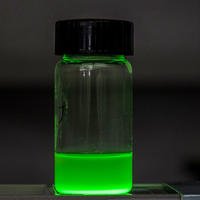A novel LED, containing halide perovskites, has been produced that is both cheap and high performing. The LED has a brightness 25 times that of LEDs in computer screens. These LEDs hold promise for the effective and economical mass production of low-cost and bright lighting.
Early work suggested perovskites could be a promising material to build LEDs. But, the performance was not up to their potential. We believed there was significant room for improvement.
Prof. Hanwei Gao - FSU

Materials that have a crystal structure with the same features as calcium titanium oxide are termed perovskites. In the past, researchers have built LEDs using perovskites; however, they have not been able to be manufacture effective LEDs. This new research, conducted at Florida State University, shows that organometal halide perovskites can be used to LEDs that demonstrate better performance if the formula of the organic-inorganic hybrid is fine-tuned.
When we thought about this class of material, we knew it should perform better than this. We came up with our novel approach to solve some critical problems and get a high-performance LED.
Prof. Biwu Ma - FSU
The team tweaked the material properties using synthetic chemistry and controlled the device architecture using device engineering. This resulted in an LED that demonstrated remarkable performance and glowed with an outstanding brightness. At 12 V driving voltage the LED had a luminosity of 10,000 cd/m2. To put this into perspective computer screens generally require LEDs that have a luminosity of 400 cd/m2.
Such exceptional brightness is, to a large extent, due to the inherent high luminescent efficiency of this surface-treated, highly crystalline nanomaterial.
Prof. Hanwei Gao - FSU
In the lab, Gao and Ma quickly and easily produced the material in approximately one hour, and they successfully created and tested a complete device within half a day.
These nanostructured perovskites demonstrate an astounding stability, even in an ambient environment, due to their specific surface chemistry. This is in contrast to bare hybrid perovskites which show low stability in humid air. This kind of chemical stability could be an advantage for cost-effective production as sophisticated infrastructure would not be required.
As LEDs are being widely adopted to reduce electric consumption, the findings of this study are very important. The adoption of LED lighting has been slower than desired as they are relatively expensive.
The U.S. Department of Energy has stated that when compared to common incandescent lighting, residential LED lighting consumes 75% less energy.
If you can get a low cost, high performing LED, everyone will go for it. For industry, our approach has a big advantage in that earth abundant materials can be processed in an economic way to make the products.
Prof. Biwu Ma - FSU
The Energy and Materials Strategic Initiative aims to produce high tech materials for advanced energy sustainable technology. Gao and Ma joined FSU as part of this initiative, and they only began collaborating by chance; their joint research began serendipitously as a result of their offices being next to each other. The team has published the study paper in the journal, Advanced Materials.